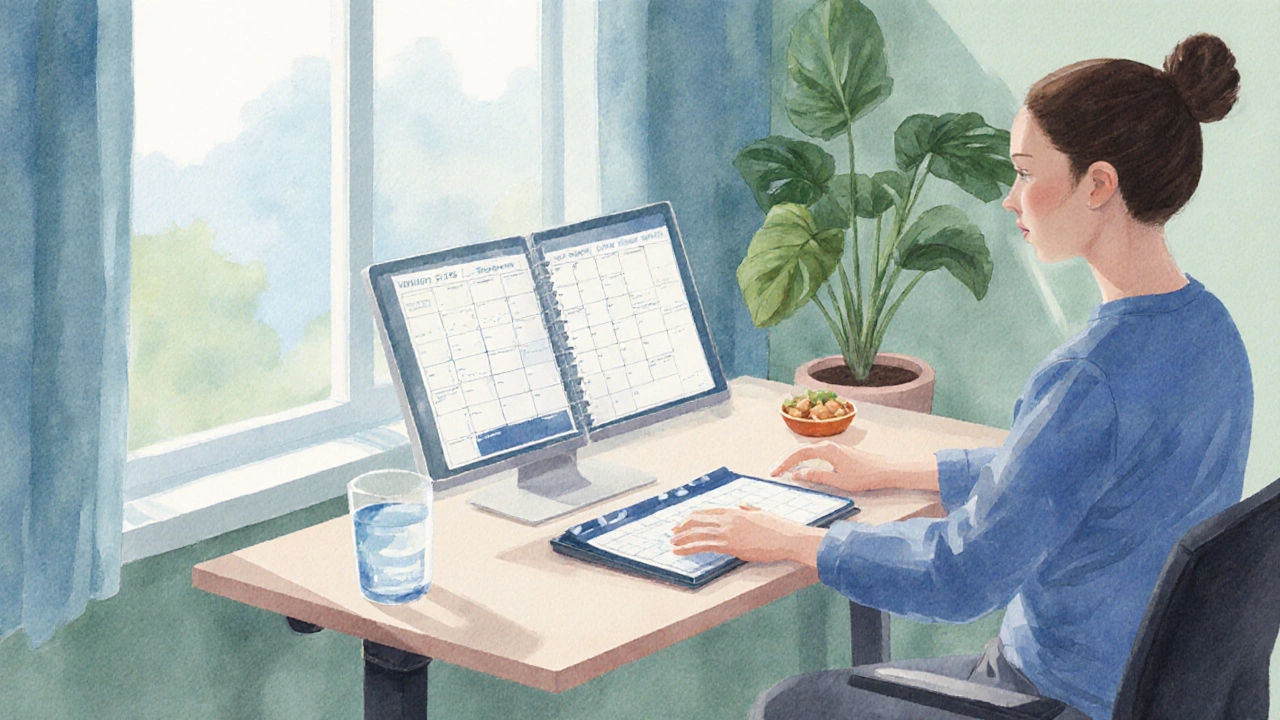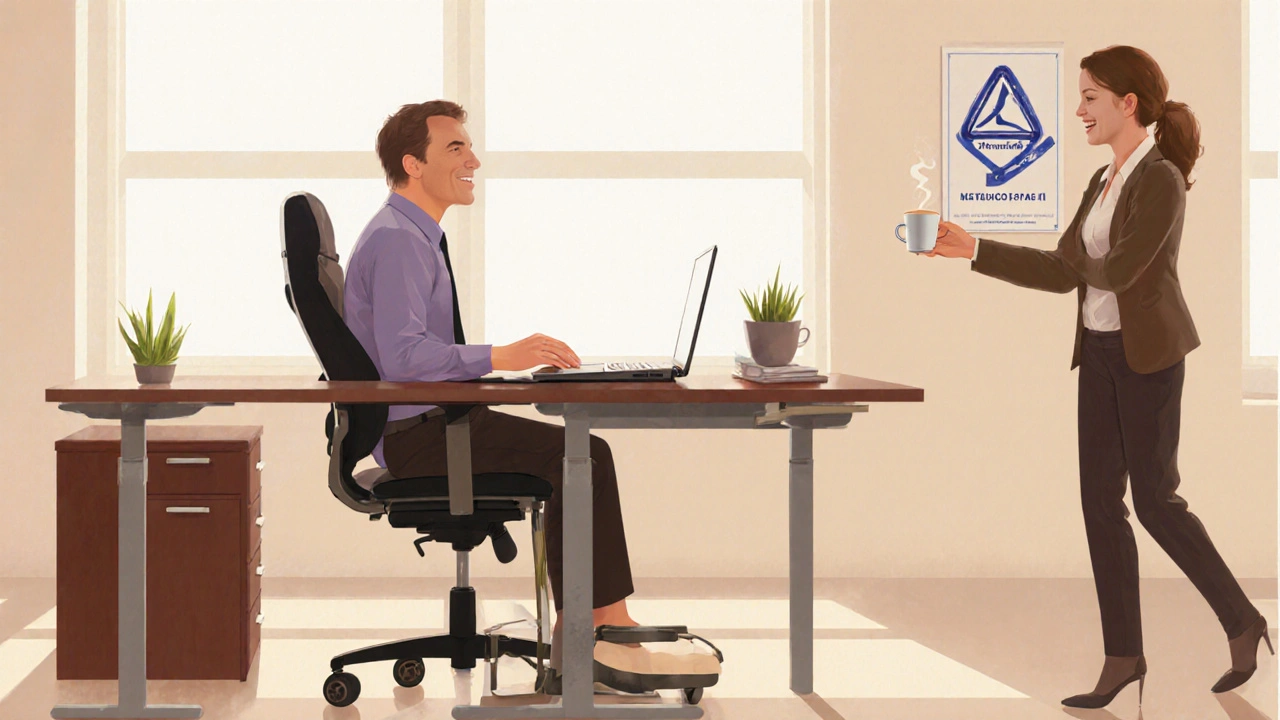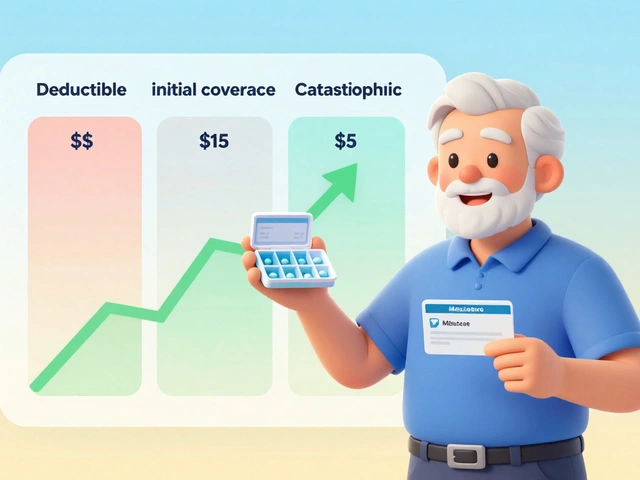Quick Takeaways
- Know your legal protections under the ADA and similar laws.
- Identify the symptoms that most affect job performance and plan around them.
- Communicate early with your employer about reasonable accommodations.
- Use simple daily routines-scheduled breaks, ergonomic tools, and stress‑reduction techniques-to keep fatigue at bay.
- Build a support network of doctors, coworkers, and online communities.
Living with Myasthenia Gravis is a chronic autoimmune disorder that weakens the muscles that control eye movement, facial expression, swallowing, and breathing can feel like juggling invisible balls while the office lights stay on. One moment you’re powering through a spreadsheet, the next you’re battling a sudden wave of fatigue. This guide shows how to stay productive, protect your health, and keep the conversation with your boss constructive.
Understanding Myasthenia Gravis and Its Workplace Impact
First, let’s break down the condition without the medical jargon. The immune system produces antibodies that block the receptors at the neuromuscular junction, meaning muscles don’t get the signal to contract fully. The result? Variable weakness that often worsens with activity and improves with rest.
Typical symptoms include drooping eyelids, double vision, difficulty chewing, and generalized fatigue that escalates after sustained exertion. In the office, those symptoms translate into trouble with prolonged screen time, trouble speaking during meetings, or an unexpected need to sit down mid‑task.
Because MG is unpredictable, the key is flexibility. Knowing when you’re likely to hit a low‑energy point-after a long commute, a stressful client call, or a late‑night shift-helps you pre‑emptively adjust your schedule.
Legal Rights and Workplace Accommodations
In the United States, the Americans with Disabilities Act (ADA) requires employers to provide reasonable accommodations to qualified employees with disabilities, unless it would cause undue hardship. Similar protections exist in the UK (Equality Act), Canada (Accessible Canada Act), and many other jurisdictions.
Reasonable accommodations might include:
- Flexible work hours or a compressed work week.
- Remote‑work options for days when fatigue spikes.
- Ergonomic equipment such as adjustable chairs, keyboards, or voice‑to‑text software.
- Permission to take short, frequent breaks without penalty.
- Modified job duties that limit prolonged speaking or heavy lifting.
Before requesting accommodations, gather supporting documentation from your doctor a licensed medical professional who can confirm diagnosis and recommend specific workplace adjustments. Most HR departments have a formal process; a well‑prepared request can speed up approval.
Practical Strategies for Daily Work Life
Legal protections are the safety net; day‑to‑day strategies keep you sailing smoothly.
1. Schedule Smart Breaks
Set a timer for every 60‑90 minutes. Stand, stretch, sip water, or simply sit with eyes closed for five minutes. This short reset prevents the muscle‑fatigue cycle that can lead to a full‑blown crisis.
2. Leverage Technology
Voice‑recognition tools like Dragon or built‑in dictation can reduce the strain of typing. Screen‑reading extensions lower eye‑strain if double vision becomes an issue. Consider a noise‑cancelling headset for virtual meetings; it cuts background chatter that can amplify fatigue.
3. Optimize Your Workstation
Invest in an adjustable monitor stand so the screen sits at eye level, minimizing neck strain. A footrest can improve circulation during long periods of sitting. If possible, ask for a sit‑stand desk-alternating positions can help maintain muscle strength.
4. Communicate Clearly
When you’re ready, have a candid conversation with your manager. Explain that MG is a condition characterized by fluctuating energy, not a permanent lack of capability. Use concrete examples: "On days when I have a 2‑hour meeting, I may need a 5‑minute break halfway through to avoid a drop in speech clarity." Framing requests as productivity boosters makes them more palatable.
5. Manage Stress
Stress hormones can worsen MG symptoms. Simple mindfulness apps, short walks, or a quick breathing exercise before a presentation can lower cortisol levels. Keep a small “stress‑relief kit” at your desk-perhaps a stress ball or a scented candle (if permitted).

When a Flare‑Up Hits the Office
Even with the best planning, flare‑ups happen. Here’s a quick action plan:
- Assess safety. If breathing becomes labored, leave the area and call emergency services.
- Notify a trusted coworker. A short text or instant message can alert someone to cover your responsibilities temporarily.
- Use medication as prescribed. Many patients carry anticholinesterase tablets for rapid symptom relief.
- Take a restorative break. A quiet room, a recliner, or simply lying down for 10 minutes can reset muscle function.
- Document the incident. Note the time, triggers, and actions taken. This data helps your doctor adjust treatment and your employer refine accommodations.
Building a Support Network
Going it alone can be exhausting. Connect with:
- Your healthcare team: a neurologist familiar with MG, a physical therapist for strength‑building exercises, and a mental‑health counselor to cope with anxiety.
- Employee Resource Groups (ERGs): many companies have disability or wellness chapters where you can share tips.
- Online communities: forums like Myasthenia Gravis Foundation or Reddit’s r/MyastheniaGravis provide real‑world advice.
Choosing the Right Treatment Plan for Work
Effective treatment reduces the frequency of severe symptoms, making accommodation requests less frequent. Common regimens include:
| Medication / Therapy | Typical Effect on Symptoms | Work‑Related Considerations |
|---|---|---|
| Anticholinesterase agents (e.g., pyridostigmine) | Improves muscle strength within 30‑60 minutes | May cause gastrointestinal upset; schedule doses around meetings |
| Immunosuppressants (e.g., azathioprine) | Reduces antibody production over weeks | Regular blood work; monitor for infection risk |
| IVIG or plasma exchange | Rapid symptom relief for severe flares | Requires clinic visits; plan for half‑day off |
| Physical therapy | Strengthens fatigued muscles | Integrate short exercise breaks during the day |
Talk to your doctor about timing doses so they align with peak work periods. Some people find taking medication right after waking yields the most stable energy throughout the day.
Next Steps: Putting the Plan into Action
1. Document your symptoms. Keep a simple log for two weeks noting energy levels, triggers, and how long it takes to recover after a break.
2. Schedule a medical review. Bring the log to your appointment and ask for a concise letter outlining recommended accommodations.
3. Draft an accommodation request. Use the table above as a reference and tailor it to your role-whether you’re a marketer, coder, or customer‑service rep.
4. Meet with HR. Present your letter, discuss options, and negotiate a trial period (e.g., two weeks) to assess effectiveness.
5. Iterate. Adjust break frequency, equipment, or remote days based on what works. Keep the dialogue open; most employers appreciate data‑driven feedback.
Living with Myasthenia Gravis at work isn’t about forcing yourself into a one‑size‑fits‑all mold. It’s about designing a personalized workflow that respects your body’s limits while showcasing your strengths.

Frequently Asked Questions
Can I request a remote‑work arrangement for Myasthenia Gravis?
Yes. Remote work is a common accommodation for fatigue‑related conditions. Provide a doctor’s note and outline how remote access will maintain or improve productivity.
What if my employer says the accommodation is too costly?
Most accommodations-like flexible scheduling, ergonomic keyboards, or brief breaks-cost little or nothing. Offer a cost‑benefit analysis showing how reduced error rates and higher morale offset the expense.
How can I handle sudden double‑vision episodes during meetings?
Notify the meeting organizer in advance that you may need a brief pause. Keep a pair of tinted glasses handy, and use the "share screen" feature to follow visual cues without relying on eye‑contact.
Is it safe to use over‑the‑counter caffeine to boost energy?
Caffeine can temporarily improve alertness, but it may also trigger tremors or increase heart rate. Discuss any stimulant use with your doctor to avoid counteracting your prescribed meds.
What legal recourse do I have if my accommodation request is denied?
You can file a complaint with the Equal Employment Opportunity Commission (EEOC) in the U.S., or the equivalent agency in your country. Having thorough medical documentation strengthens your case.




Henry Kim on 28 September 2025, AT 16:37 PM
Living with Myasthenia Gravis definitely calls for a flexible schedule, so setting a recurring reminder to stand up and stretch every hour can keep the fatigue curve flat. Pair that with a voice‑to‑text app for those long emails, and you’ll conserve muscle strength for the tasks that truly need your focus. It never hurts to let your manager know in advance that you may need short, frequent breaks; most HR teams are used to handling these requests under the ADA. Building a small “toolbox” of ergonomic accessories-like a footrest or a sit‑stand converter-helps keep the body in a neutral posture throughout the day. Remember, the goal is to design a workflow that works with your body, not against it.